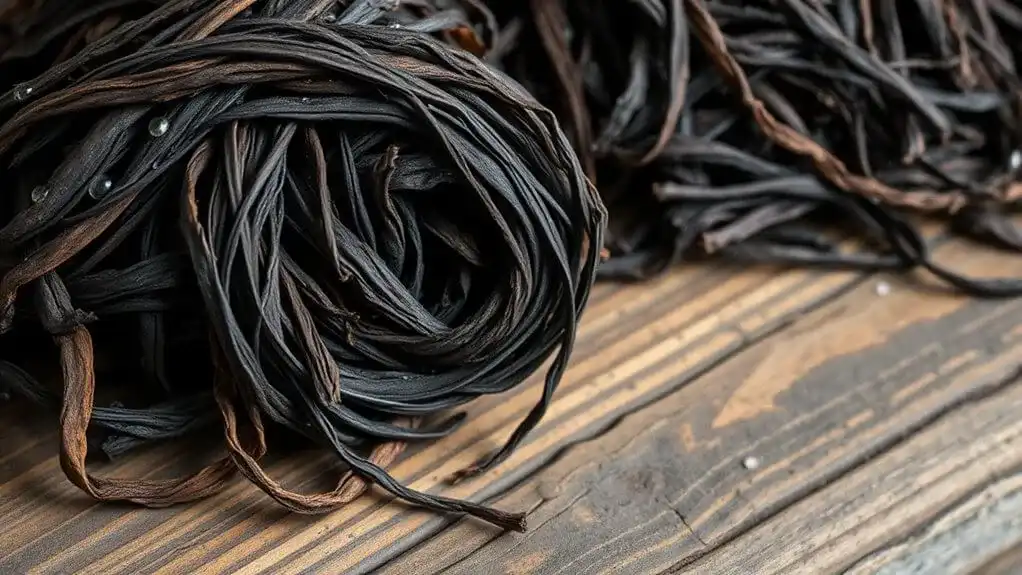Pu-erh tea's unique character comes from post-fermentation, where microorganisms like Aspergillus niger transform the tea's compounds during controlled processing. Unlike traditional teas that rely on oxidation, pu-erh undergoes true fermentation through wet-piling in the wo-dui process, creating its distinctive dark red color and rich flavor profile. While ripe pu-erh offers immediate depth through accelerated fermentation, raw varieties can develop complex flavors for up to 60 years. The journey from leaf to cup reveals nature's remarkable alchemy.
Key Points
- Post-fermentation in Pu-erh relies on microorganisms, primarily Aspergillus niger, transforming tea compounds to create unique flavors and dark coloration.
- The Wo-dui process involves wet-piling under controlled moisture and temperature conditions, allowing specific microbes to ferment tea leaves effectively.
- Environmental factors like moisture, temperature, and aeration must be carefully monitored during fermentation to achieve desired flavor profiles.
- Raw Pu-erh ages naturally over decades, while ripe Pu-erh undergoes accelerated fermentation through controlled wet-piling for faster maturation.
- Proper drying after fermentation is crucial to halt microbial activity and preserve the tea's desired characteristics and flavor profile.
The Art and Science Behind Post-Fermentation
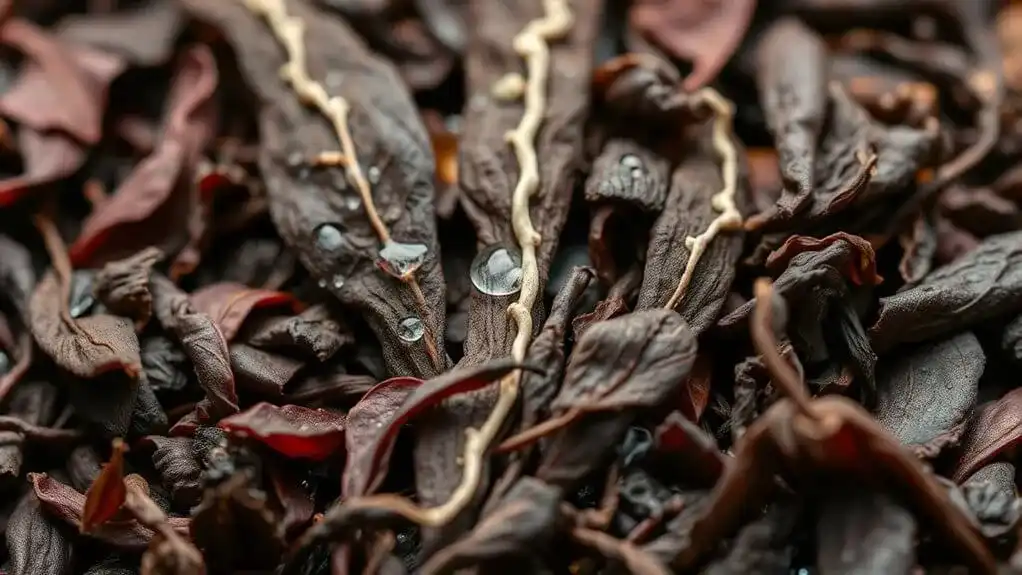
While traditional tea processing often relies on enzymatic oxidation, post-fermentation represents a distinct and complex transformation that harnesses the power of microorganisms. The process begins when tea leaves undergo initial heat treatment and compression, creating ideal conditions for microbial interactions that fundamentally alter the tea's character. The transformation yields a dark red color in most fully processed varieties. True fermentation methods are what distinguish post-fermented teas from other varieties. Studies reveal that microbial diversity decreases when fresh tea leaves become pu-erh.
The science behind post-fermentation techniques involves carefully controlled environments where fungi like Aspergillus niger and various bacteria break down the tea's organic matter. This process thrives at temperatures between 22-26 degrees Celsius, with humidity playing a vital role in the development of unique flavors. Different cultures have refined these methods over centuries, from the barrel fermentation of Japanese Goishicha to the distinctive production of Chinese pu-erh. The result is a remarkable transformation that creates complex, mature flavors through natural microbial activity.
From Raw Leaves to Complex Flavors
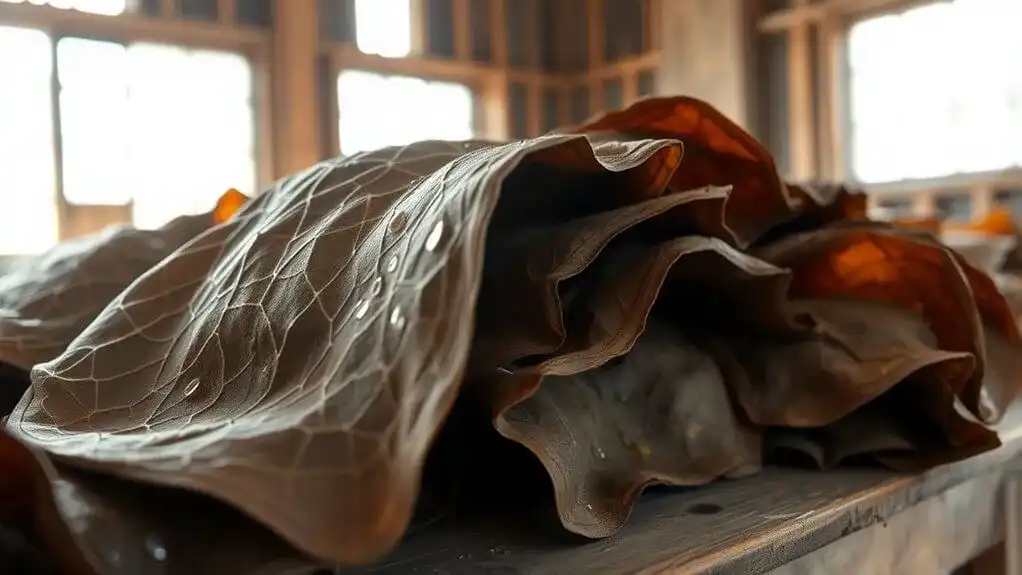
The journey from raw tea leaves to complex-flavored Pu-erh begins with careful selection of the Yunnan big leaf variety of Camellia Sinensis. After leaf selection, the process moves through withering, stir-frying, and rolling stages, each contributing to the tea's foundation. Sun-drying completes the raw Pu-erh processing before the vital transformation begins. Premium quality is ensured by harvesting leaves during optimal seasons only. The leaves undergo bacterial and fungal growth during fermentation that creates the distinctive taste.
The wo-dui process transforms these raw leaves through controlled post-fermentation, where wet-piling and temperature management create ideal conditions for microbial activity. This careful flavor balancing results in the tea's signature characteristics – thick, smooth, and savory notes reminiscent of dates and ginseng. While raw Pu-erh requires decades to mature naturally, this accelerated fermentation achieves similar complexity in markedly less time, though final quality depends heavily on both initial leaf quality and fermentation expertise. Modern producers ensure quality by using ventilated facilities that optimize the fermentation environment.
Key Microorganisms Shaping Pu-erh's Profile
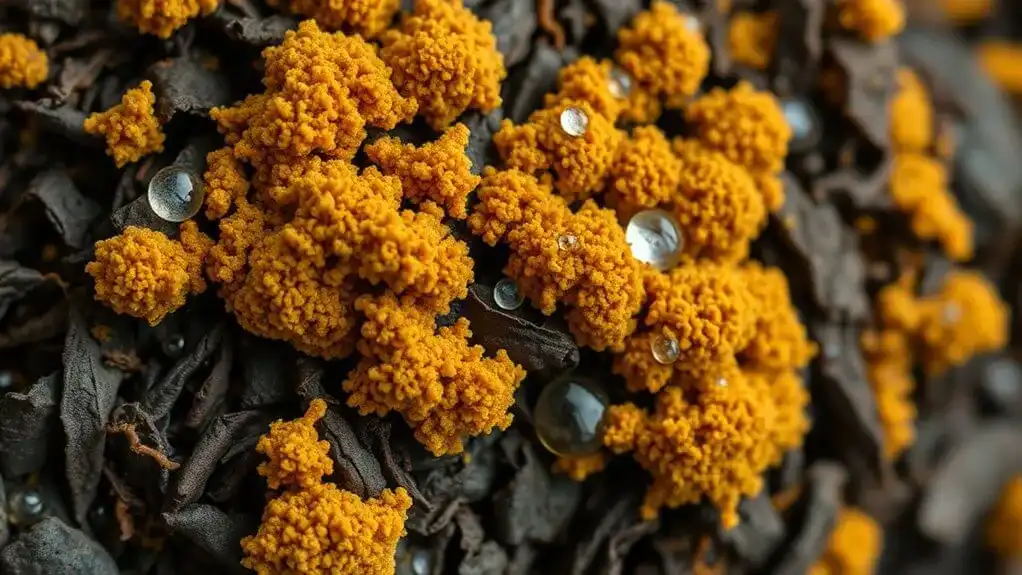
Among the diverse microorganisms involved in Pu-erh fermentation, Aspergillus niger stands as the predominant force driving the tea's transformation. Through complex microbial interactions, A. niger alters the tea's metabolite profile, influencing both bacterial and fungal communities. It's responsible for identifying 200 different metabolites, with significant changes in amino acid-related compounds that shape the tea's distinctive flavor compounds. Warm and moist conditions during processing provide the ideal environment for these microbial transformations to occur.
While A. niger leads the fermentation process, other key players like Penicillium, Rhizopus, and various bacterial species contribute to the tea's development. The ripening degree over years significantly impacts the development of these microbial communities and their metabolic activities. These microorganisms work together differently in Sheng and Shu Pu-erh varieties, with Sheng showing higher bacterial diversity and unique Aspergillus concentrations. Through their combined activity, they catalyze vital chemical transformations, including degradation, isomerism, and polymerization, ultimately crafting Pu-erh's complex character.
Environmental Factors in Tea Fermentation

During tea fermentation, environmental conditions greatly influence both microbial activity and metabolite development. In pu-erh tea production, controlled moisture levels trapped within the tea cakes create a prime environment for beneficial microorganisms like Aspergillus niger to thrive and transform the tea's characteristics. Studies have shown that surface area availability directly impacts how effectively fermentation occurs. The fermentation process typically requires 7 to 10 days under proper aerobic conditions to achieve optimal results. The process requires careful monitoring of multiple variables, including temperature and aeration, which directly affect the rate and quality of fermentation.
pH adjustments play an essential role, particularly in kombucha fermentation, where the formation of acetic acid depends on maintaining ideal pH conditions. Light exposure also impacts the fermentation process, though its effects vary depending on the type of tea being produced. These environmental factors don't work in isolation but interact synergistically to shape the final flavor profile and quality of fermented teas.
Raw vs. Ripe: Two Paths to Excellence
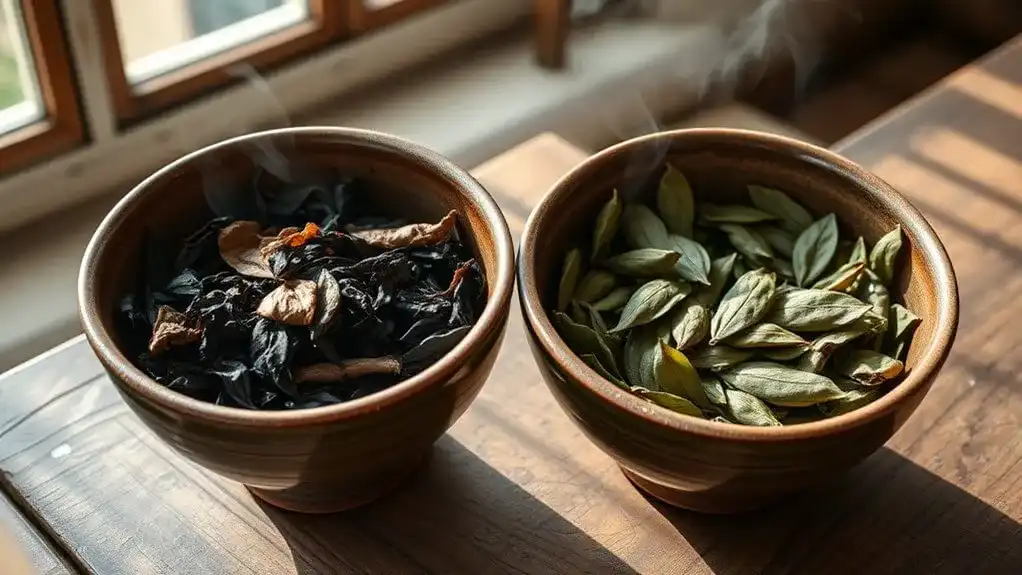
While both types of Pu-erh tea emerge from the same leaf source, raw and ripe varieties follow distinctly different processing paths that yield unique characteristics. Raw Pu-erh undergoes traditional processing, with leaves carefully withered, pan-fried, and sun-dried to preserve essential enzymes for natural aging. Its raw characteristics develop over decades, resulting in evolving complexity and increasing value. This traditional method traces back to the Tang Dynasty origins, when merchants first discovered the benefits of aging tea during transport. This aging potential can extend significantly, with some premium raw Pu-erh teas capable of developing flavor for up to 60 years.
In contrast, ripe Pu-erh experiences accelerated fermentation through wet-piling, where tea masters control moisture and temperature to achieve desired ripe nuances. This process involves careful pile management and quality control to prevent off-flavors. While ripe Pu-erh offers immediate richness with notes of dates and ginseng, it continues to develop smoother, more savory qualities with proper storage, though less dramatically than its raw counterpart.
Mastering the Fermentation Timeline
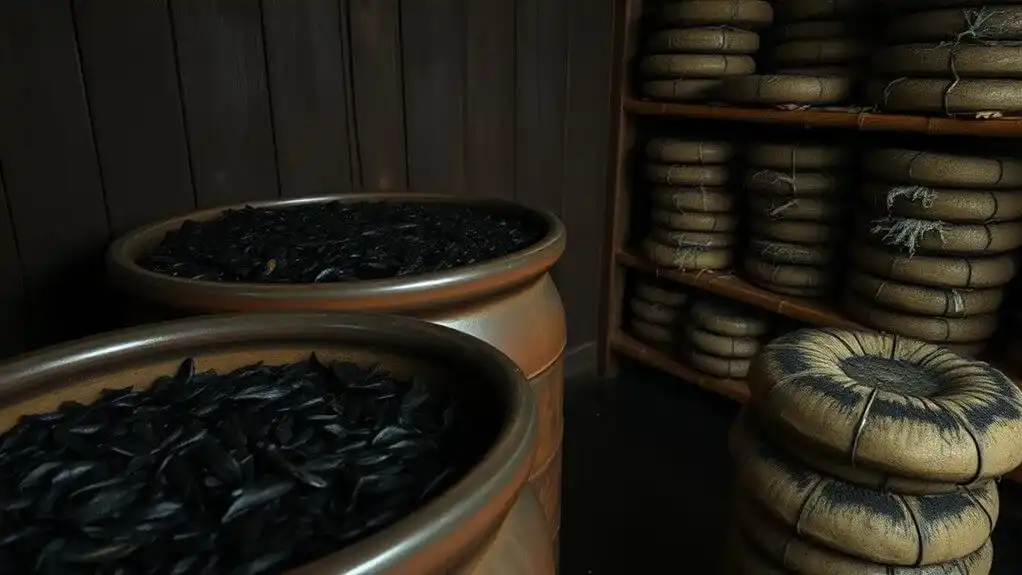
The art of pu-erh fermentation follows precise timelines that determine the tea's final character. Raw pu-erh takes the slow road, naturally aging for 20-30 years as microorganisms gradually transform its chemical composition. In contrast, modern fermentation techniques accelerate this process through wo-dui, a controlled method that mimics the natural aging process in a fraction of the time. The process relies on careful monitoring, much like how hot-feed driers maintain quality in traditional black tea production.
Similar to how airflow is critical in kombucha brewing, during wo-dui, tea masters carefully monitor moisture levels and temperature while repeatedly turning the piled leaves to guarantee even fermentation. The process relies heavily on Aspergillus niger and other microbes that thrive in these controlled conditions. Once the desired fermentation level is reached, the tea is thoroughly dried to halt microbial activity. This strategic management of the aging process creates ripe pu-erh's distinctive characteristics in weeks rather than decades.
Conclusion
The intricate dance of microorganisms, time, and environment transforms simple tea leaves into pu-erh's complex character. But isn't it fascinating how nature's smallest beings create such profound changes? Post-fermentation's careful orchestration continues to captivate tea enthusiasts and scientists alike, as they unravel the mysteries behind this ancient process. Whether raw or ripe, pu-erh stands as a demonstration of humanity's mastery over fermentation and time.
